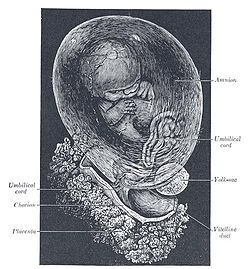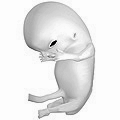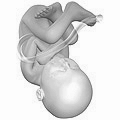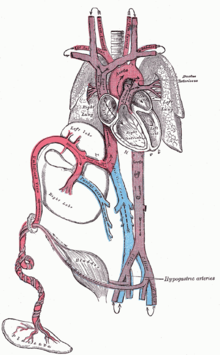| Revision as of 02:24, 9 March 2008 editAnythingyouwant (talk | contribs)Extended confirmed users, Pending changes reviewers, Template editors91,261 edits Restoring longstanding info about USA Today article. See talk page. Two editors believe this longstanding info should not be deleted.← Previous edit | Revision as of 02:25, 9 March 2008 edit undoOrangemarlin (talk | contribs)30,771 editsm Reverted to revision 196910012 by Ferrylodge; The USA Today, the fine paragon of journalism that it is, is not a reliable source..using TWNext edit → | ||
| Line 26: | Line 26: | ||
| ====9 to 15 weeks==== | ====9 to 15 weeks==== | ||
| ] is 1.25 inches.<ref>Marc H. Bornstein, Michael E. Lamb. , page 227 (2005): "At 8 weeks, fetuses measure 3.18 cm from crown to rump (1.25 inches)."</ref>]] The fetal stage commences at nine weeks after fertilization (or the 11th week of ]).<ref> "The fetal stage is from the beginning of the 9th week after fertilization and continues until birth"</ref> At the beginning of the fetal stage, the fetus is typically about 30 mm (1.2 inches) in length from crown to rump and the head makes up nearly half of the fetus' size.<ref></ref> During this stage, the fetus moves involuntarily as tissues, organs and pathways begin to develop.<ref>White, Lois. , pages 10 and 128 (2004): "By the end of the 12th week, skeletal muscles begin involuntary movements....The newborn may cry and have muscular activity when cold, but there is no voluntary control of muscular activity."</ref><ref>Valman, H. and Pearson, J. "", ''British Medical Journal'', (January 26, 1980). Retrieved ]: "Nine weeks after conception...fingers round an object in the palm of his hand. In response to a touch on the sole of his foot...hips and knees to move away from the touching object."</ref><ref>Butterworth, George and Harris, Margaret. '''', page 48 (Psychology Press 1994): "stretch and yawn pattern at 10 weeks."</ref><ref name="Prechtl">Prechtl, Heinz. in ''Handbook of brain and behaviour in human development'', Kalverboer and Gramsbergen eds., pp. 415-418 (2001 Kluwer Academic Publishers): "At 9-10 weeks postmenstrual age complex and generalized movements occur....solated movements of one arm or leg emerge 1 week later."</ref> The parts of the fetal brain that control movement will not fully form until late in the second trimester, and the first part of the third trimester.{{cn}} The heart, hands, feet, and brain are present, but are not fully formed and are not yet functional.<ref>'''' (Sixth Edition). Retrieved ].</ref> Breathing-like movement of the fetus is necessary for stimulation of lung development, rather than for obtaining oxygen.<ref>Institute of Medicine of the National Academies, '''' (2006). Retrieved ].</ref><ref>Greenfield, Marjorie. “". Retrieved ].</ref> Publishing their findings in the ''The Journal of the American Medical Association'', a group of researchers at the ] concluded that fetuses are likely incapable of feeling pain in the first or second trimester.<ref name="JAMA"> {{cite journal | last = Lee | first = Susan | title = Fetal Pain A Systematic Multidisciplinary Review of the Evidence | journal = The Journal of the American Medical Association | volume = 294 | issue = 8 | date = August 24/31, 2005 | publisher = the American Medical Association | ] is 1.25 inches.<ref>Marc H. Bornstein, Michael E. Lamb. , page 227 (2005): "At 8 weeks, fetuses measure 3.18 cm from crown to rump (1.25 inches)."</ref>]] The fetal stage commences at nine weeks after fertilization (or the 11th week of ]).<ref> "The fetal stage is from the beginning of the 9th week after fertilization and continues until birth"</ref> At the beginning of the fetal stage, the fetus is typically about 30 mm (1.2 inches) in length from crown to rump and the head makes up nearly half of the fetus' size.<ref></ref> During this stage, the fetus moves involuntarily as tissues, organs and pathways begin to develop.<ref>White, Lois. , pages 10 and 128 (2004): "By the end of the 12th week, skeletal muscles begin involuntary movements....The newborn may cry and have muscular activity when cold, but there is no voluntary control of muscular activity."</ref><ref>Valman, H. and Pearson, J. "", ''British Medical Journal'', (January 26, 1980). Retrieved ]: "Nine weeks after conception...fingers round an object in the palm of his hand. In response to a touch on the sole of his foot...hips and knees to move away from the touching object."</ref><ref>Butterworth, George and Harris, Margaret. '''', page 48 (Psychology Press 1994): "stretch and yawn pattern at 10 weeks."</ref><ref name="Prechtl">Prechtl, Heinz. in ''Handbook of brain and behaviour in human development'', Kalverboer and Gramsbergen eds., pp. 415-418 (2001 Kluwer Academic Publishers): "At 9-10 weeks postmenstrual age complex and generalized movements occur....solated movements of one arm or leg emerge 1 week later."</ref> The parts of the fetal brain that control movement will not fully form until late in the second trimester, and the first part of the third trimester.{{cn}} The heart, hands, feet, and brain are present, but are not fully formed and are not yet functional.<ref>'''' (Sixth Edition). Retrieved ].</ref> Breathing-like movement of the fetus is necessary for stimulation of lung development, rather than for obtaining oxygen.<ref>Institute of Medicine of the National Academies, '''' (2006). Retrieved ].</ref><ref>Greenfield, Marjorie. “". Retrieved ].</ref> Publishing their findings in the ''The Journal of the American Medical Association'', a group of researchers at the ] concluded that fetuses are likely incapable of feeling pain in the first or second trimester.<ref name="JAMA"> {{cite journal | last = Lee | first = Susan | title = Fetal Pain A Systematic Multidisciplinary Review of the Evidence | journal = The Journal of the American Medical Association | volume = 294 | issue = 8 | date = August 24/31, 2005 | publisher = the American Medical Association | ||
| | url = http://jama.ama-assn.org/cgi/content/full/294/8/947 | accessdate = 2008-02-14 }} |
| url = http://jama.ama-assn.org/cgi/content/full/294/8/947 | accessdate = 2008-02-14 }}</ref><ref> MSNBC</ref> | ||
| From weeks 9 to 12, the fetal eyelids close and remain closed for several months, and the appearance of the genitals in males and females becomes more apparent.<ref name="medline" /> ] buds appear, the ]s are long and thin, and ]s are produced in the ], however the majority of red blood cells will be made later in gestation (at 21 weeks) by bone marrow.<ref></ref> A fine hair called ] develops on the head. The gastrointestinal tract, still forming, starts to collect sloughed skin and lanugo, as well as hepatic products, forming ] (stool).<ref></ref> Fetal ] is almost transparent. The first measurable signs of ] movement occur in the 12th week.<ref>Vogel, Friedrich. '''' (Springer 2000): "Slow EEG activity (0.5 – 2 c/s) can be demonstrated in the fetus even at the conceptual age of three months." Retrieved ].</ref> By the end of this stage, the fetus has reached about 15 cm (6 inches). | From weeks 9 to 12, the fetal eyelids close and remain closed for several months, and the appearance of the genitals in males and females becomes more apparent.<ref name="medline" /> ] buds appear, the ]s are long and thin, and ]s are produced in the ], however the majority of red blood cells will be made later in gestation (at 21 weeks) by bone marrow.<ref></ref> A fine hair called ] develops on the head. The gastrointestinal tract, still forming, starts to collect sloughed skin and lanugo, as well as hepatic products, forming ] (stool).<ref></ref> Fetal ] is almost transparent. The first measurable signs of ] movement occur in the 12th week.<ref>Vogel, Friedrich. '''' (Springer 2000): "Slow EEG activity (0.5 – 2 c/s) can be demonstrated in the fetus even at the conceptual age of three months." Retrieved ].</ref> By the end of this stage, the fetus has reached about 15 cm (6 inches). | ||
Revision as of 02:25, 9 March 2008
For other uses, see Foetus (band). "Unborn child" redirects here. For the Seals and Crofts album, see Unborn Child (album).
A fetus (or foetus or fœtus) is a developing mammal or other viviparous vertebrate, after the embryonic stage and before birth. The plural is fetuses, or sometimes feti.
In humans, the fetal stage of prenatal development begins nine weeks after fertilization (or eleven weeks in gestational age), when the major structures and organ systems are forming, until birth.
Etymology and spelling variations
The word fetus is from the Latin fetus, meaning offspring, bringing forth, hatching of young. It has Indo-European roots related to sucking or suckling.
Foetus is an English variation on the Latin spelling, and has been in use since at least 1594, according to the Oxford English Dictionary, which describes "fetus" as "etymologically preferable ... but in actual use ... almost unknown", and gives foetus as the standard spelling. The variant foetus or fœtus may have originated with an error by Saint Isidore of Seville, in AD 620. The preferred spelling in the United States is fetus, but the variants foetus and fœtus persist in other English-speaking countries and in some medical contexts, as well as in some other languages (e.g., French).
Human fetus
The fetal stage begins nine weeks after fertilization, and the blastocyst and zygote stages. The risk of miscarriage decreases sharply at the beginning of the fetal stage. The fetus is not as sensitive to damage from environmental exposures as the embryo was, though toxic exposures can often cause physiological abnormalities or minor congenital malformation. Fetal growth can be terminated by various factors, including miscarriage, feticide committed by a third party, or induced abortion.
Development
The following timeline describes some of the specific changes in fetal anatomy and physiology by fertilization age (i.e. the time elapsed since fertilization). Obstetricians often use "gestational age" which, by convention, is measured from 2 weeks earlier than fertilization. For purposes of this article, age is measured from fertilization, except as noted.
9 to 15 weeks

The fetal stage commences at nine weeks after fertilization (or the 11th week of gestational age). At the beginning of the fetal stage, the fetus is typically about 30 mm (1.2 inches) in length from crown to rump and the head makes up nearly half of the fetus' size. During this stage, the fetus moves involuntarily as tissues, organs and pathways begin to develop. The parts of the fetal brain that control movement will not fully form until late in the second trimester, and the first part of the third trimester. The heart, hands, feet, and brain are present, but are not fully formed and are not yet functional. Breathing-like movement of the fetus is necessary for stimulation of lung development, rather than for obtaining oxygen. Publishing their findings in the The Journal of the American Medical Association, a group of researchers at the University of California, San Francisco concluded that fetuses are likely incapable of feeling pain in the first or second trimester.
From weeks 9 to 12, the fetal eyelids close and remain closed for several months, and the appearance of the genitals in males and females becomes more apparent. Tooth buds appear, the limbs are long and thin, and red blood cells are produced in the liver, however the majority of red blood cells will be made later in gestation (at 21 weeks) by bone marrow. A fine hair called lanugo develops on the head. The gastrointestinal tract, still forming, starts to collect sloughed skin and lanugo, as well as hepatic products, forming meconium (stool). Fetal skin is almost transparent. The first measurable signs of EEG movement occur in the 12th week. By the end of this stage, the fetus has reached about 15 cm (6 inches).
16 to 25 weeks

The lanugo covers the entire body. Eyebrows, eyelashes, fingernails, and toenails appear. The fetus has increased muscle development. Alveoli (air sacs) are forming in lungs. The nervous system develops enough to control some body functions. The cochlea are now developed, though the myelin sheaths in the neural portion of the auditory system will continue to develop until 18 months after birth. The respiratory system has developed to the point where gas exchange is possible. The quickening, the first maternally discernable fetal movements, are often felt during this period. A woman pregnant for the first time (i.e. a primiparous woman) typically feels fetal movements at about 18-19 weeks, whereas a woman who has already given birth at least two times (i.e. a multiparous woman) will typically feel movements around 16 weeks. By the end of the fifth month, the fetus is about 20 cm (8 inches).
26 to 38 weeks

The amount of body fat rapidly increases. Lungs are not fully mature. Thalamic brain connections, which mediate sensory input, form. Bones are fully developed, but are still soft and pliable. Iron, calcium, and phosphorus become more abundant. Fingernails reach the end of the fingertips. The lanugo begins to disappear, until it is gone except on the upper arms and shoulders. Small breast buds are present on both sexes. Head hair becomes coarse and thicker. Birth is imminent and occurs around the 38th week. The fetus is considered full-term between weeks 35 and 40, which means that the fetus is considered sufficiently developed for life outside the uterus. It may be 48 to 53 cm (19 to 21 inches) in length, when born.
Variation in growth
See also: Birth weightThere is much variation in the growth of the fetus. When fetal size is less than expected, that condition is known as intrauterine growth restriction (IUGR) also called fetal growth restriction (FGR); factors affecting fetal growth can be maternal, placental, or fetal.
Maternal factors include maternal weight, body mass index, nutritional state, emotional stress, toxin exposure (including tobacco, alcohol, heroin, and other drugs which can also harm the fetus in other ways), and uterine blood flow.
Placental factors include size, microstructure (densities and architecture), umbilical blood flow, transporters and binding proteins, nutrient utilization and nutrient production.
Fetal factors include the fetus genome, nutrient production, and hormone output. Also, female fetuses tend to weigh less than males, at full term.
Fetal growth is often classified as follows: small for gestational age (SGA), appropriate for gestational age (AGA), and large for gestational age (LGA). SGA can result in low birth weight, although premature birth can also result in low birth weight. Low birth weight increases risk for perinatal mortality (death shortly after birth), asphyxia, hypothermia, polycythemia, hypocalcemia, immune dysfunction, neurologic abnormalities, and other long-term health problems. SGA may be associated with growth delay, or it may instead be associated with absolute stunting of growth.
Viability
Five months is currently the lower limit of viability, and viability usually occurs later. According to The Developing Human:
Viability is defined as the ability of fetuses to survive in the extrauterine environment... There is no sharp limit of development, age, or weight at which a fetus automatically becomes viable or beyond which survival is assured, but experience has shown that it is rare for a baby to survive whose weight is less than 500 gm or whose fertilization age is less than 22 weeks. Even fetuses born between 26 and 28 weeks have difficulty surviving, mainly because the respiratory system and the central nervous system are not completely differentiated... If given expert postnatal care, some fetuses weighing less than 500 gm may survive; they are referred to as extremely low birth weight or immature infants.... Prematurity is one of the most common causes of morbidity and prenatal death.
During the past several decades, expert postnatal care has improved with advances in medical science, and therefore the point of viability may have moved earlier. As of 2006, the youngest child to survive a premature birth was a girl born at the Baptist Hospital of Miami at 21 weeks and 6 days' gestational age.
Fetal pain
Main article: Fetal painFetal pain, its existence, and its implications are debated politically and academically. According to the conclusions of a review in The Journal of the American Medical Association published in 2005, "Evidence regarding the capacity for fetal pain is limited but indicates that fetal perception of pain is unlikely before the third trimester." However, there may be an emerging consensus among developmental neurobiologists that the establishment of thalamocortical connections" (at about 26 weeks) is a critical event with regard to fetal perception of pain. Nevertheless, because pain can involve sensory, emotional and cognitive factors, it is "impossible to know" when painful experiences may become possible, even if it is known when thalamocortical connections are established.
Whether a fetus has the ability to feel pain and to suffer is part of the abortion debate. For example, legislation has been proposed by pro-life advocates requiring abortion providers to tell a woman that the fetus may feel pain during the abortion procedure, and that require her to accept or decline anesthesia for the fetus.
Circulatory system

The circulatory system of a human fetus works differently from that of born humans, mainly because the lungs are not in use: the fetus obtains oxygen and nutrients from the woman through the placenta and the umbilical cord.
Blood from the placenta is carried to the fetus by the umbilical vein. About half of this enters the fetal ductus venosus and is carried to the inferior vena cava, while the other half enters the liver proper from the inferior border of the liver. The branch of the umbilical vein that supplies the right lobe of the liver first joins with the portal vein. The blood then moves to the right atrium of the heart. In the fetus, there is an opening between the right and left atrium (the foramen ovale), and most of the blood flows from the right into the left atrium, thus bypassing pulmonary circulation. The majority of blood flow is into the left ventricle from where it is pumped through the aorta into the body. Some of the blood moves from the aorta through the internal iliac arteries to the umbilical arteries, and re-enters the placenta, where carbon dioxide and other waste products from the fetus are taken up and enter the woman's circulation.
Some of the blood from the right atrium does not enter the left atrium, but enters the right ventricle and is pumped into the pulmonary artery. In the fetus, there is a special connection between the pulmonary artery and the aorta, called the ductus arteriosus, which directs most of this blood away from the lungs (which aren't being used for respiration at this point as the fetus is suspended in amniotic fluid).
Postnatal development
Main article: Adaptation to extrauterine lifeWith the first breath after birth, the system changes suddenly. The pulmonary resistance is dramatically reduced ("pulmo" is from the Latin for "lung"). More blood moves from the right atrium to the right ventricle and into the pulmonary arteries, and less flows through the foramen ovale to the left atrium. The blood from the lungs travels through the pulmonary veins to the left atrium, increasing the pressure there. The decreased right atrial pressure and the increased left atrial pressure pushes the septum primum against the septum secundum, closing the foramen ovale, which now becomes the fossa ovalis. This completes the separation of the circulatory system into two halves, the left and the right.
The ductus arteriosus normally closes off within one or two days of birth, leaving behind the ligamentum arteriosum. The umbilical vein and the ductus venosus closes off within two to five days after birth, leaving behind the ligamentum teres and the ligamentum venosus of the liver respectively.
Differences from the adult circulatory system
Remnants of the fetal circulation can be found in adults:
| Fetal | Adult |
|---|---|
| foramen ovale | fossa ovalis |
| ductus arteriosus | ligamentum arteriosum |
| extra-hepatic portion of the fetal left umbilical vein | ligamentum teres hepatis (the "round ligament of the liver"). |
| intra-hepatic portion of the fetal left umbilical vein (the ductus venosus) | ligamentum venosum |
| proximal portions of the fetal left and right umbilical arteries | umbilical branches of the internal iliac arteries |
| distal portions of the fetal left and right umbilical arteries | medial umbilical ligaments (urachus) |
In addition to differences in circulation, the developing fetus also employs a different type of oxygen transport molecule than adults (adults use adult hemoglobin). Fetal hemoglobin enhances the fetus' ability to draw oxygen from the placenta. Its association curve to oxygen is shifted to the left, meaning that it will take up oxygen at a lower concentration than adult hemoglobin will. This enables fetal hemoglobin to absorb oxygen from adult hemoglobin in the placenta, which has a lower pressure of oxygen than at the lungs.
Developmental problems
See also: Congenital disorder
Congenital anomalies are anomalies that are acquired before birth. Infants with certain congenital anomalies of the heart can survive only as long as the ductus remains open: in such cases the closure of the ductus can be delayed by the administration of prostaglandins to permit sufficient time for the surgical correction of the anomalies. Conversely, in cases of patent ductus arteriosus, where the ductus does not properly close, drugs that inhibit prostaglandin synthesis can be used to encourage its closure, so that surgery can be avoided.
A developing fetus is highly susceptible to anomalies in its growth and metabolism, increasing the risk of birth defects. One area of concern is the pregnant woman's lifestyle choices made during pregnancy Diet is especially important in the early stages of development. Studies show that supplementation of the woman's diet with folic acid reduces the risk of spina bifida and other neural tube defects. Another dietary concern is whether the woman eats breakfast. Skipping breakfast could lead to extended periods of lower than normal nutrients in the woman's blood, leading to a higher risk of prematurity, or other birth defects in the fetus. During this time alcohol consumption may increase the risk of the development of Fetal alcohol syndrome, a condition leading to mental retardation in some infants. Smoking during pregnancy may also lead to reduced birth weight. Low birth weight is defined as 2500 grams (5.5 lb). Low birth weight is a concern for medical providers due to the tendency of these infants, described as premature by weight, to have a higher risk of secondary medical problems.
Legal issues
Main articles: Abortion Debate and Fetal rightsIn the United States, some states have laws that impose strict punishments for those who inflict violence that results in damage to a fetus or the unwanted termination of a pregnancy. The severity of the punishment, and the stage of fetal development where laws start to apply vary from state to state.
Abortion of a fetus is legal in many countries such as Australia, Canada, Mexico, UK and USA.
Non-human fetuses
| This section needs expansion. You can help by adding to it. (March 2007) |

The fetus of most mammals develops similarly to the Homo sapiens fetus. After the first stages of development, the human embryo reaches a stage very similar to all other vertebrates. The anatomy of the area surrounding a fetus is different in litter-bearing animals compared to humans: each fetus is surrounded by placental tissue and is lodged along one of two long uteri instead of the single uterus found in a human female. Development at birth is similar, with animals also having a poorly developed sense of vision and other senses.
See also
References
- Introductory to Maternal Nursing "The fetal stage is from the beginning of the 9th week after fertilization and continues until birth"
- MedicineNet.com. See also Dictionary.com.
- Some authorities suggest that the embryonic stage may last only seven weeks. See Encyclopedia Britannica: "In humans, the organism is called an embryo for the first seven or eight weeks after conception, after which it is called a fetus." Also see People v. Taylor, California Supreme Court: "beyond the embryonic stage of seven to eight weeks."
- Harper, Douglas. (2001). Online Etymology Dictionary. Retrieved 2007-01-20.
- The American Heritage Dictionary of the English Language, Fourth Edition. Retrieved 2007-01-22.
- Aronson, Jeff (July 1997). "When I use a word...:Oe no!". British Medical Journal. 315 (1). BMJ Publishing Group Ltd. Retrieved 2006-06-29.
- • Q&A: Miscarriage. (August 6 , 2002). BBC News. Retrieved 2007-04-22: “The risk of miscarriage lessens as the pregnancy progresses. It decreases dramatically after the 8th week.”
• Lennart Nilsson, A Child is Born 91 (1990): at eight weeks, "the danger of a miscarriage … diminishes sharply."
• “Women’s Health Information”, Hearthstone Communications Limited: “The risk of miscarriage decreases dramatically after the 8th week as the weeks go by.” Retrieved 2007-04-22. - Marc H. Bornstein, Michael E. Lamb. Developmental Science: An Advanced Textbook, page 227 (2005): "At 8 weeks, fetuses measure 3.18 cm from crown to rump (1.25 inches)."
- Introductory to Maternal Nursing "The fetal stage is from the beginning of the 9th week after fertilization and continues until birth"
- MedlinePlus
- White, Lois. Foundations Of Maternal & Pediatric Nursing, pages 10 and 128 (2004): "By the end of the 12th week, skeletal muscles begin involuntary movements....The newborn may cry and have muscular activity when cold, but there is no voluntary control of muscular activity."
- Valman, H. and Pearson, J. "What the Fetus Feels", British Medical Journal, (January 26, 1980). Retrieved 2007-03-04: "Nine weeks after conception...fingers round an object in the palm of his hand. In response to a touch on the sole of his foot...hips and knees to move away from the touching object."
- Butterworth, George and Harris, Margaret. Principles of developmental psychology, page 48 (Psychology Press 1994): "stretch and yawn pattern at 10 weeks."
- Prechtl, Heinz. "Prenatal and Early Postnatal Development of Human Motor Behavior" in Handbook of brain and behaviour in human development, Kalverboer and Gramsbergen eds., pp. 415-418 (2001 Kluwer Academic Publishers): "At 9-10 weeks postmenstrual age complex and generalized movements occur....solated movements of one arm or leg emerge 1 week later."
- The Columbia Encyclopedia (Sixth Edition). Retrieved 2007-03-05.
- Institute of Medicine of the National Academies, Preterm Birth: Causes, Consequences, and Prevention (2006). Retrieved 2007-03-04.
- Greenfield, Marjorie. “Dr. Spock.com". Retrieved 2007-01-20.
- ^ Lee, Susan (August 24/31, 2005). "Fetal Pain A Systematic Multidisciplinary Review of the Evidence". The Journal of the American Medical Association. 294 (8). the American Medical Association. Retrieved 2008-02-14.
{{cite journal}}: Check date values in:|date=(help) - "Study: Fetus feels no pain until third trimester" MSNBC
- Cite error: The named reference
medlinewas invoked but never defined (see the help page). - MedlinePlus
- MedlinePlus
- Vogel, Friedrich. Genetics and the Electroencephalogram (Springer 2000): "Slow EEG activity (0.5 – 2 c/s) can be demonstrated in the fetus even at the conceptual age of three months." Retrieved 2007-03-05.
- Levene, Malcolm et al. Essentials of Neonatal Medicine (Blackwell 2000), page 8. Retrieved 2007-03-04.
- Your Pregnancy: 36 Weeks BabyCenter.com Retrieved June 1, 2007.
- Word Web Online, retrieved 2007-01-26.
- ^ Holden, Chris and MacDonald, Anita. Nutrition and Child Health (Elsevier 2000). Retrieved 2007-03-04.
- Queenan, John. Management of High-Risk Pregnancy (Blackwell 1999). Retrieved 2007-03-04.
- Halamek, Louis. "Prenatal Consultation at the Limits of Viability", NeoReviews, Vol.4 No.6 (2003): "most neonatologists would agree that survival of infants younger than approximately 22 to 23 weeks’ estimated gestational age is universally dismal and that resuscitative efforts should not be undertaken when a neonate is born at this point in pregnancy."
- Moore, Keith and Persaud, T. (2003). The Developing Human: Clinically Oriented Embryology'. Philadelphia: Saunders. pp. p. 103. ISBN 0-7216-9412-8.
{{cite book}}:|pages=has extra text (help)CS1 maint: multiple names: authors list (link) - Roe v. Wade, 410 U.S. 113 (1973) ("viability is usually placed at about seven months (28 weeks) but may occur earlier, even at 24 weeks.") Retrieved 2007-03-04.
- Baptist Hospital of Miami, Fact Sheet (2006).
- ^ Johnson, Martin and Everitt, Barry. Essential reproduction (Blackwell 2000): "The multidimensionality of pain perception, involving sensory, emotional, and cognitive factors may in itself be the basis of conscious, painful experience, but it will remain difficult to attribute this to a fetus at any particular developmental age." Retrieved 2007-02-21.
- White, R. Frank. "Are We Overlooking Fetal Pain and Suffering During Abortion?", American Society of Anesthesiologists Newsletter (October 2001). Retrieved 2007-03-10.
- David, Barry & and Goldberg, Barth. "Recovering Damages for Fetal Pain and Suffering", Illinois Bar Journal (December 2002). Retrieved 2007-03-10.
- Weisman, Jonathan. "House to Consider Abortion Anesthesia Bill", Washington Post 2006-12-05. Retrieved 2007-02-06.
- ^ Whitaker, Kent. Comprehensive Perinatal and Pediatric Respiratory Care (Delmar 2001). Retrieved 2007-03-04.
- Dudek, Ronald and Fix, James. Board Review Series Embryology (Lippincott 2004). Retrieved 2007-03-04.
- University of Michigan Medical School, Fetal Circulation and Changes at Birth. Retrieved 2007-03-04.
- Dalby, JT. (1978).Environmental effects on prenatal development Journal of Pediatric Psychology, 3, 105-109.
- Streissguth, A. (1997). Fetal Alcohol Syndrome: A Guide for Families and Communities. Baltimore: Brookes Publishing. ISBN 1-55766-283-5.
- National Conference of State Legislatures. (June 2006). "Fetal Homicide". Retrieved January 19, 2007.
- ZFIN, Pharyngula Period (24-48 h). Modified from: Kimmel et al., 1995. Developmental Dynamics 203:253-310. Downloaded 5 March 2007.
External links
| Preceded byEmbryo | Stages of human development Fetus |
Succeeded byInfant |
| Human embryonic development in the first three weeks | |||||||||
|---|---|---|---|---|---|---|---|---|---|
| Week 1 | |||||||||
| Week 2 (Bilaminar) | |||||||||
| Week 3 (Trilaminar) |
| ||||||||


